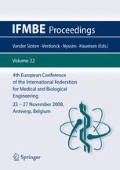Abstract
During ventricular fibrillation (VF), a portion of myocardial tissue can be captured by pacing at a rate near the fibrillation rate. Interruption of ventricular fibrillation can be favored by achieving stable myocardial capture, lowering the energy required for electrical cardioversion. Existence of myocardial capture during electrical stimulation is determined by visual inspection of electrograms (EGM) by an experienced observer. The objective of this work is the development of a semi-automatic method for the detection of myocardial capture based on the 2D correlation of isochronal maps. In 4 isolated rabbit hearts VF was induced by ventricular pacing with an increasing rate. An array of 128 sensing electrodes plus a central electrode for pacing was used. For each experiment, an isochronal capture template (TImap) was computed by using isochronal maps corresponding to pacing before the induction of VF. After VF induction, epicardial pacing was delivered during 15 seconds at the same rate of the spontaneous fibrillatory rate and 10% higher. An experienced observer visually inspected the recordings and identified which stimulations resulted in capture. Isochronal maps were generated by automatically detecting the myocardial activation during VF. Detections of the algorithm were compared with captures previously identified by the observer. Our algorithm discarded 73.35% of non-capture cases and missed only one capture case reducing the time required for analyzing myocardial capture experiments. This is the first method that makes use of 2D correlation to detect myocardial capture during VF.
Access this chapter
Tax calculation will be finalised at checkout
Purchases are for personal use only
Preview
Unable to display preview. Download preview PDF.
References
Saxon LA.(2005) Sudden cardiac death: Epidemiology and temporal trends. Rev Cardiovasc Med 6:S12–20.
Chorro FJ, et al. (2002) Effects of acute reduction of temperature on ventricular fibrillation. American Journal of Physiology Heart and Circulatory Physiology 283:H2331–H2340.
Ideker RE, et al. (2004) Types of ventricular fibrillation: 1,2,4,5, or 300,000?. J Cardiovasc Electrophysiol; 15:1441–1443.
Jalife J. (2000) Ventricular fibrillation: Mechanisms of initiation and maintenance. Annu Rev Physiol;62:25
Adgey AAJ, et al. (2005) Theory and practice of defibrillation: (2) Defibrillation for ventricular fibrillation. Heart; 91:118–125.
Johnson PhL, et al. (2003) Adaptive pacing during ventricular fibrillation. Pacing Clin Electrophysiol; 26:1824–1836.
Allessie M, et al. (1991) Regional control of atrial fibrillation by rapid pacing in conscious dogs. Circulation 84:1689–1697.
Pak HN, et al. (2004) Improvement of defibrillation efficacy with preshock synchronized pacing. J Cardiovasc Electrophysiol; 15:581–587.
Kirchhof C, et al. (1993) Regional entrainment of atrial fibrillation studied by high-resolution mapping in open-chest dogs. Circulation; 88;736–749.
Rogers J.M. et al. (1997) A quantitative framework for analyzing epicardial activation patterns during ventricular fibrillation. Annals of Biomed. Eng. 25;749–760.
Author information
Authors and Affiliations
Corresponding author
Editor information
Editors and Affiliations
Rights and permissions
Copyright information
© 2009 Springer-Verlag Berlin Heidelberg
About this paper
Cite this paper
Ibáñez-Català, X. et al. (2009). 2D Isochronal Correlation Method to Detect Pacing Capture during Ventricular Fibrillation. In: Vander Sloten, J., Verdonck, P., Nyssen, M., Haueisen, J. (eds) 4th European Conference of the International Federation for Medical and Biological Engineering. IFMBE Proceedings, vol 22. Springer, Berlin, Heidelberg. https://doi.org/10.1007/978-3-540-89208-3_5
Download citation
DOI: https://doi.org/10.1007/978-3-540-89208-3_5
Publisher Name: Springer, Berlin, Heidelberg
Print ISBN: 978-3-540-89207-6
Online ISBN: 978-3-540-89208-3
eBook Packages: EngineeringEngineering (R0)

